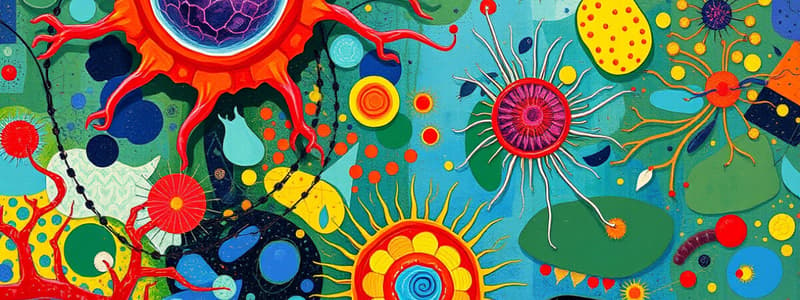Podcast
Questions and Answers
What is the likely cause of Frank's respiratory distress and high fever?
What is the likely cause of Frank's respiratory distress and high fever?
- Parasitic infection
- Fungal infection (correct)
- Viral pneumonia
- Bacterial infection
Which of the following treatments did Frank NOT receive?
Which of the following treatments did Frank NOT receive?
- Itraconazole
- Penicillin (correct)
- Cefotiam hydrochloride
- Amphotericin B
What symptom indicated that Frank's immune system was fighting an infection?
What symptom indicated that Frank's immune system was fighting an infection?
- Decreased white blood cell count
- Normal C-reactive protein levels
- Elevated white blood cell count (correct)
- Absence of cough
What abnormal finding was observed in Frank's CT scan?
What abnormal finding was observed in Frank's CT scan?
What type of fungus is Aspergillus fumigatus classified as?
What type of fungus is Aspergillus fumigatus classified as?
What is the primary process by which many eukaryotic microbes, such as yeasts, reproduce asexually?
What is the primary process by which many eukaryotic microbes, such as yeasts, reproduce asexually?
Which of the following is a key characteristic of the diploid form of protozoa?
Which of the following is a key characteristic of the diploid form of protozoa?
Which two major categories classify microbial eukaryotes?
Which two major categories classify microbial eukaryotes?
What modification of mitotic cell division is required for gamete formation in eukaryotic cells?
What modification of mitotic cell division is required for gamete formation in eukaryotic cells?
Which eukaryotic organisms are characterized by features such as hyphae and yeast?
Which eukaryotic organisms are characterized by features such as hyphae and yeast?
What is a defining trait of eukaryotic cells compared to prokaryotic cells?
What is a defining trait of eukaryotic cells compared to prokaryotic cells?
In which stage does genetic variation in protozoa typically increase?
In which stage does genetic variation in protozoa typically increase?
What role do algae play in the classification of microbial eukaryotes?
What role do algae play in the classification of microbial eukaryotes?
What does the term 'protozoa' literally mean?
What does the term 'protozoa' literally mean?
Which of the following types of organisms are considered 'microbial eukaryotes'?
Which of the following types of organisms are considered 'microbial eukaryotes'?
Which of the following is NOT a type of human pathogen listed in the content?
Which of the following is NOT a type of human pathogen listed in the content?
Which disease is caused by the protozoan Plasmodium?
Which disease is caused by the protozoan Plasmodium?
Which group of organisms includes Candida and Aspergillus?
Which group of organisms includes Candida and Aspergillus?
Trypanosoma brucei is responsible for which of the following diseases?
Trypanosoma brucei is responsible for which of the following diseases?
Which of the following diseases is caused by Cryptosporidium?
Which of the following diseases is caused by Cryptosporidium?
Amebas primarily affect which part of the human body?
Amebas primarily affect which part of the human body?
What type of organisms are classified as protists?
What type of organisms are classified as protists?
What type of pathogens are helminths classified as?
What type of pathogens are helminths classified as?
Which organism is primarily responsible for causing amoebic dysentery?
Which organism is primarily responsible for causing amoebic dysentery?
What is a primary characteristic of yeasts?
What is a primary characteristic of yeasts?
Which of the following is a common pathogen responsible for trichomoniasis?
Which of the following is a common pathogen responsible for trichomoniasis?
Which organism is a free-living amoeba associated with primary amoebic meningoencephalitis?
Which organism is a free-living amoeba associated with primary amoebic meningoencephalitis?
What structure do fungal hyphae possess that makes them resilient?
What structure do fungal hyphae possess that makes them resilient?
Which species is known to cause a rare algal infection in immunocompromised individuals?
Which species is known to cause a rare algal infection in immunocompromised individuals?
Which of the following statements is true regarding microsporidia?
Which of the following statements is true regarding microsporidia?
Which organism is primarily associated with balantidiasis?
Which organism is primarily associated with balantidiasis?
What is one main advantage of yeasts in their environment?
What is one main advantage of yeasts in their environment?
Which of the following arthropods directly infect humans?
Which of the following arthropods directly infect humans?
Flashcards are hidden until you start studying
Study Notes
Eukaryotic Microbes & Invertebrate Infectious Agents
- Eukaryotes consist of fungi, protists, and helminths.
- Eukaryotic cell structure: a nucleus with linear chromosomes, membranous organelles (ER, Golgi, vacuoles), mitochondria, and chloroplasts.
- Asexual reproduction: mitotic cell division leading to indefinite proliferation.
- Sexual reproduction: involves gamete formation through meiosis, creating a diploid zygote.
- Microbial eukaryotes: categorized as fungi, protozoa, and algae.
- Fungi: characterized by hyphae, yeast, and their ability to cause diseases like athlete's foot and systemic infections.
- Protozoa: diverse group including amoebas, paramecia, apicomplexans, trypanosomes, metamonads, and ciliates.
- Helminths: parasitic worms, like roundworms, tapeworms, and flukes.
- Invertebrate parasites: arthropods, like mites, lice, mosquitoes, ticks, and fleas, can be vectors for pathogens.
- Yeast: single-celled fungi capable of both sexual and asexual reproduction.
- Hyphae: filaments forming the fungal mycelium, composed of chitin, glucans, mannans, and proteins.
- Mycelium: network of interwoven hyphae.
- Specialized hyphae: involved in nutrient uptake and reproduction.
- Fungal diseases: caused by various yeasts, molds, and dimorphic fungi, affecting different organs and systems.
- Microsporidia: obligate intracellular parasites, primarily affecting immunocompromised individuals.
- Algae: mostly non-pathogenic to humans, but some species can cause diseases in immunocompromised individuals.
Fungi and Microsporidians
- Yeast: single-celled fungi capable of sexual and asexual reproduction.
- Fungal mycelium: a network of interwoven hyphae, responsible for nutrient absorption and reproduction.
- Fungal diseases: caused by yeasts, molds, and dimorphic fungi, with varied symptoms and severity.
- Microsporidiosis: caused by obligate intracellular parasites, primarily affecting immunocompromised individuals.
Studying That Suits You
Use AI to generate personalized quizzes and flashcards to suit your learning preferences.




